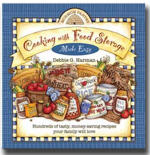
Cooking with Food Storage Made Easy by Debbie G. Harman is a very nicely illustrated, easy-to-read book on food storage. The hardcover spiral binding is durable and easy to use in the kitchen. Her introductions to each section are easy going and simple and there are a variety of good recipes in this book. She also includes pages throughout the book to make your own notes. Debbie has written for a Latter-day Saint audience on the Wasatch Front, though.
The first chapter, “Stocking the Basics for Food Storage,” offers a good list of basic foods to use as the “essential” foods in your storage. I would recommend either storing more grains or storing more powdered milk as her recommendations don’t match either of the researched amounts of 300 lbs grains and 75 lbs milk or 400 lbs grains and 16 lbs milk. She has 310 lbs grains and 24 lbs milk. She does include a shelf life list for the foods in her essentials list but she needs to include more information on storage conditions to achieve that shelf life and be consistent in the packaging methods in the list. Also included is a list of dehydrated foods (be aware of the typo on the dried potato recommendation); a good list of herbs, spices and seasonings; a list of baking or cooking items; a list of condiments; and a list of non-food items to consider storing.
Debbie includes sections in this book that you don’t often find in food storage books – information on canning and preserving food. Please remember that her recommended amounts of home canned foods are to supplement fresh foods and are not enough to eat for a year. You will need to supplement her chapters on canning and preserving with your canner instruction manual and at least one of these 3 books – the USDA manual on canning and preserving, So Easy to Preserve from the University of Georgia, or the Ball Blue Book of Preserving. Some of her recipes do not consider current recommendations for the use of thickeners and not all recipes include the jar size to use for the specified processing times. Her processing times are for altitudes of either 3,000-6,000 feet or 4,000-6,000 feet and she doesn’t tell you how to adjust for lower altitudes.
The information on dehydrating needs to be more complete especially for the jerky. Dried meat has food safety precautions to keep in mind. Again, refer to one of the previously mentioned books for more detail.
Instructions for sprouting are included. These are good basic instructions that will get you started growing and using sprouts.
The good thing about including information on canning, freezing, dehydrating, and sprouting is that it may get people who have never done these things interested in trying them.
The recipes begin with main and side dishes that use only shelf stable foods. I was very encouraged that these recipes were included but disappointed that the majority of the remaining recipes in the book use fresh or frozen ingredients. She states that home canned or dried foods can be substituted for fresh but doesn’t tell you how. She includes recipes for wheat, cornmeal, oats, and rice in the grains recipe section and includes a good variety of ways to use them, especially those using whole wheat flour. You will find a recipe for pizza dough, scones, pita bread, and even cold cereal in addition to the normal bread, rolls, biscuits, muffins, and pancakes. And speaking of rice, apparently she doesn’t realize that Cal Rose rice is medium grain and not long grain rice as she has illustrated on the cover and throughout the book!
The last section in this book is on emergency preparedness. If offers some good information but it’s not important to the book as a food storage book. Also, the list of websites she said she was including at the end seems to be missing.
This book is a useful book especially if you live on the Wasatch Front. It’s a very inviting book to read and use and there is enough variety in the recipes that I think anyone could find many recipes to try.
Note: This edition does not appear to be available any more. See the 2021 version.
